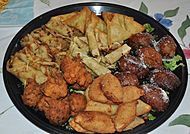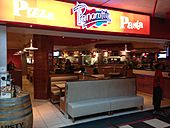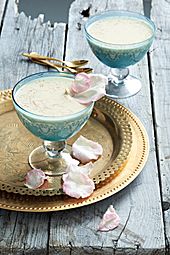South African cuisine facts for kids
South Africa has a rich and varied food culture! It mixes different traditions from the many groups of people who live there. Long ago, the Khoisan people found and ate over 300 types of plants. One important plant was the rooibos shrub, which is still used today.
Later, the Bantu people arrived. They brought farming and raised animals like cattle. This added new foods and ways to preserve meat. Bantu-speaking communities also created many dishes that are still enjoyed in towns and cities across South Africa.
Contents
A Taste of History
Long ago, the San people were hunter-gatherers. They found food like tortoises, crayfish, and different plants. Farming came to South Africa with the Bantu people. They learned to grow foods like maize, squash, and sweet potatoes.
In the 1600s, people from the Netherlands and United Kingdom moved to South Africa. They brought their own cooking styles. The Cape Malay community created a special type of food. It came from Southeast Asian cooking. Later, Afrikaner travelers called voortrekkers mixed Dutch, Khoisan, Cape Malay, and Bantu foods to fit their traveling life. French people, called Huguenots, also came. Many settled in Franschhoek and helped start South Africa's wine industry.
During British rule, many people from Asia arrived, especially from India. They brought amazing spices, seasonings, and dishes. Indian cuisine is now popular all over South Africa and enjoyed by everyone.
During a time called apartheid, South Africa faced challenges. But places called shebeens became popular. These were informal community centers, especially for Black South Africans. They kept their cultural and food traditions alive there. After apartheid ended, South African food became very popular again. Many different types of food are now available in cities for tourists and locals. South African foods are also becoming more known around the world!
Traditional African Cooking
Before European settlers arrived, local cooking used many wild foods. These included fruits, nuts, and plants. People also hunted wild animals. When Bantu speakers arrived, they brought domestic cattle and grains. This meant people could have fresh meat more often.
The old diet mainly included cooked grains like sorghum and millet. They also ate fermented milk, which is like yogurt. Meat was often roasted or stewed. Over time, maize became the main grain.
People also raised sheep and goats. Big hunts for wild game were common. But beef was seen as the most important and special meat. The ribs of a slaughtered cow were so valued that they were given to the village chief.
Today, the daily food of many South African families comes from these old traditions. A common meal in a Bantu-speaking home is a thick, fluffy porridge made from maize meal. It is called pap. It is often served with a tasty meat stew. Some families ferment their pap for a few days. This gives it a tangy flavor. The Sotho-Tswana people call this fermented pap, ting.
Common Vegetables include different kinds of pumpkin, which grow naturally in South Africa. Rice and beans are also very popular, even though they are not native. Another common vegetable dish is shredded cabbage and white potatoes cooked with butter. This dish came to South Africa with Irish immigrants.
For many South Africans, meat is the main part of any meal. The Khoisan people ate roasted meat and also dried it for later. This love for meat is still seen in the popular South African barbecue, called a braai. Biltong (dried preserved meat) is also very popular. Just like in the past, South Africans prefer beef.
Today, South Africans enjoy beef, mutton, goat, and chicken. On weekends, many families have a braai. The meal usually includes pap en vleis, which is maize meal and grilled meat. Eating meat is even a special ritual in South African culture.
For weddings, initiations, or when family returns from a long trip, families often buy an animal. They slaughter it at home and prepare a big meal for the community. People believe that spilling the animal's blood on the ground pleases their ancestors. On holiday weekends, people sell live animals like sheep and goats along roads. Families buy them to slaughter, cook, and eat. For weddings, richer families often buy a live steer.
Most Black South Africans are surprised by vegetarianism. However, most meals are served with vegetables like pumpkin, beans, and cabbage.
There is also a meal called 'mphokoqo' (Xhosa) or 'uphuthu' (Zulu). It is sometimes called an "African salad." It is made from maize meal mixed with a small amount of water. It comes out lumpy and dry but soft when hot. It is usually mixed with 'amasi', which is fermented milk. This dish was a favorite of former President Nelson Mandela.
Other Cooking Styles
In the 1600s, new foods like biltong, droëwors, and rusks were created in South Africa. This happened out of need during the early days of settlement.
Cape Dutch and Cape Malay Cooking
A unique cooking style in South Africa is "Cape Dutch" food. It uses many spices like nutmeg, allspice, and chili peppers. This style was greatly influenced by the slaves brought to the Cape by the Dutch East India Company. These slaves came from places like Bengal, Java, and Malaysia. This is why you see Eastern spices and names in many dishes.
The Cape Malay influence brought spicy curries, sambals (spicy sauces), pickled fish, and different fish stews.
Bobotie is a South African dish with Cape Malay roots. It is spiced minced meat baked with an egg topping. Bobotie is almost like the national dish of South Africa. It is not commonly found in other countries. The recipe came from the Dutch East India Company colonies in Batavia. Its name comes from the Indonesian word bobotok. It has curry powder, which gives it a slight tangy taste. It is often served with sambal, showing its origins from the Malay Archipelago.
South African yellow rice is a sweet dish. It is made with turmeric, raisins, cinnamon, and sugar. It also comes from Cape Malay cooking. People often call it Cape Malay yellow rice.
French Cooking
French Huguenot refugees brought their wines and traditional recipes from France.
Indian Cooking
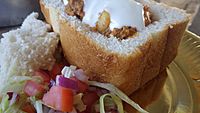
Curried dishes are popular in South Africa among all ethnic groups. Many dishes came with thousands of Indian workers in the 1800s. South African Indian food has added many dishes and cooking ways. These include different curries, sweets, chutneys, and fried snacks like samosa.
Bunny chow is a dish from Durban. Durban is a city with a large Indian community. Bunny chow is a hollowed-out loaf of bread filled with curry. It has become very popular across South Africa.
Drinks to Enjoy
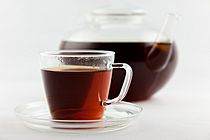
Beer has been an important drink in South Africa for hundreds of years. Local people brewed traditional beer from grains like sorghum long before Europeans arrived. Beer was so special that it was part of many ceremonies, like weddings. One family would offer beer to the other family.
Traditional South African beer was not filtered and was cloudy. It had a low alcohol content. In the early 1900s, people found that traditional beer gave important vitamins. These vitamins were sometimes missing from the grain-heavy diet, especially for workers in cities.
When mines were built and Black South Africans moved to cities, women also moved. They started brewing beer for the male workers. Many of these men were single or had left their wives in rural areas. This tradition of urban women making beer continues today. Informal bars called shebeens are often owned by women, known as shebeen queens.
Today, most city dwellers buy beer from large breweries. This beer is like what you would find in Europe or America. But people in rural areas still enjoy the cloudy, traditional beer.
Milk and milk products are very important in the traditional Black South African diet. Cows were highly valued in the past, so milk was plentiful. Since there was no refrigeration, different kinds of soured milk, like yogurt, were a main food. In the 1800s, visitors to any African village would be offered a large bowl of cool fermented milk as a welcome.
Because milk cows allowed women to stop breastfeeding earlier, local cultures had sayings about cattle, milk, and population growth. For example, the Sotho-Tswana saying, "cattle beget children."
Today, supermarkets in South Africa sell many types of milk. You can find sour milk, sour cream, and other modern versions of traditional milk products.
Restaurants and Fast Food
South Africa has a big "eating out" culture. Some restaurants specialize in traditional South African dishes. Others offer foods from places like Morocco, China, West Africa, and Japan. These can be found in all major cities. There are also many local restaurant chains, like Spur and Dulce Cafe.
Fast-food restaurants are also very common. International chains like Kentucky Fried Chicken and McDonald's are there. But they face strong competition from local chains. These include Nando's, Galito's, Steers, Chicken Licken, Barcelos, and King Pie. Many South African restaurant chains have also successfully opened in other countries.
Popular South African Foods
Savoury Dishes
-
Boerewors roll
Meats and Game
- Biltong—dried meat, often beef, seasoned with coriander seeds and salt. You can also find it made from springbok, kudu, chicken, or ostrich.
- Boerewors—a sausage traditionally grilled on a braai (barbecue).
- Droëwors—dried sausage, made like boerewors but without pork. It is dried like biltong.
- Frikkadels—meatballs, usually baked but sometimes deep-fried.
- Bokkoms—whole, salted, and dried mullet fish.
- Skilpadjies—lamb's liver wrapped in a fatty membrane and grilled over hot coals.
- Smoked or braaied snoek—a local game fish.
- Sosatie—a kebab of grilled marinated meat on a skewer.
- Amanqina—chicken feet, cow feet, pig feet, or lamb feet. Eaten with pap or as a special treat.
- Walkie Talkies—grilled or deep-fried chicken feet and beaks.
- Ostrich—a popular meat with low cholesterol. Used in stews or grilled.
Main Meals
- Mashonja/Matamani—made from Mopani worms.
- Gesmoorde vis—salted cod or snoek with potatoes and tomato sauce.
- Hoenderpastei—chicken pot pie, a traditional Afrikaans dish.
- Kaiings—made from lamb tail or flank, cooked slowly. They are chewy and often served over pap or with honey.
- Mielie-meal—a main food, often cooked into pap.
- Oepsies—a starter for a braai. Cherries wrapped in bacon and covered in barbecue sauce.
- Paptert—a tart made from pap, cheese, canned tomatoes, and bacon. A side dish for a braai.
- Potjiekos—a traditional Afrikaans stew. Made with meat and vegetables, cooked over coals in cast-iron pots.
- Tomato bredie—a lamb and tomato stew.
- Waterblommetjiebredie—meat stewed with the flower of the Cape pondweed.
- Biryani—a mixed rice dish from the Indian subcontinent.
- Bunny chow—curry stuffed into a hollowed-out loaf of bread. Locals sometimes call it Kota. They might fill it with chips, polony (bologna), cheese, and atchar (pickle).
- Durban curry—spicier than the Cape Malay version. Often made with mutton and spices like cayenne pepper, paprika, and cinnamon.
- Bobotie—a dish of Malay origin. It is like meatloaf with raisins and a baked egg topping. Often served with yellow rice, sambals, and chutney.
- Cape Malay curry—often chicken curry with mild spices like cinnamon, ginger, and turmeric.
- Dombolo—dumplings, usually steamed.
- Isidudu—soft porridge made from ground corn (mealie meal).
- Mala mogodu—a local dish similar to tripe. Eaten with hot pap and spinach.
- Iinkobe—summer salad made with boiled corn.
- Sigwaqani—boiled beans mixed with mealie-meal.
- Mqhavunyeko—wet corn mixed with beans.
- Trotters and beans—from the Cape. Made from boiled pig's or sheep's trotters, onions, and beans.
- Ugali—maize porridge, a main food for African peoples.
- Umngqusho—a dish made from white maize and sugar beans. A main food for the Xhosa people.
- Umphokoqo—an African salad made of maize meal.
- Umvubo—sour milk mixed with dry pap, often eaten by the Xhosa.
Breads
- Braaibroodjie—a sandwich grilled on a braai. It has tomato, cheese, onion, and South African peach chutney.
- Gatsby—a popular sandwich in Cape Town. A long roll filled with things like polony (bologna), chicken, steak, and hot chips.
- Potbrood (pot bread)—savoury bread baked over coals in cast-iron pots.
- Samosa, or samoosa—a savoury stuffed Indian pastry that is fried. Very popular.
- Kota, Skhambane (also known as Bunny Chow)—a sandwich. A quarter-loaf of bread usually stuffed with polony (bologna), cheese, atchar (pickle), and chips.
Relishes
- Chakalaka—a spicy South African vegetable relish.
- Chutney, or blatjang—a sweet fruit sauce often poured on meat.
- Monkey gland sauce—made of onion, garlic, ginger, chutney, soy sauce, mustard, Worcestershire sauce, ketchup, and wine. (No monkeys are involved!)
Fruits and Plants
- Makataan—a wild fruit from the Kalahari desert. Used to make a jam called Makataan konfyt.
- Marula—the yellow fruit of a local tree. Eaten by people and animals. Amarula liqueur is made from this fruit. The ripe fruit is also used for jams, wine, and beer.
- Morogo—a spinach-like wild plant. Traditionally boiled and served with pap.
Sweet Treats
- Hertzoggie—a small tart with apricot jam and a dried coconut meringue topping.
- Koeksisters—a sweet treat. Afrikaans koeksisters are twisted pastries, deep-fried and very sweet. Koeksisters from the Cape Flats are sweet and spicy, shaped like large eggs, and deep-fried.
- Malva pudding—a sweet, spongy apricot pudding of Dutch origin.
- Melktert—a milk-based tart or dessert.
- Melkkos—a traditional South African dish. Served as a meal on its own.
- Mealie-bread—a sweet bread baked with sweetcorn.
- Mosbolletjies—a sweet bun made with aniseed and grape juice.
- Pampoenkoekies (pumpkin fritters)—fritters where pumpkin is used instead of or with flour.
- Peppermint crisp tart—a traditional fridge tart made with peppermint crisp chocolate, caramel, biscuits, and cream.
- Rusks—a hard, dry biscuit eaten after being dipped in tea or coffee.
- Vetkoek (fat cake, doughnut, Amagwinya in isiXhosa)—deep-fried dough balls. Often stuffed with meat or served with snoek fish or jam.
Drinks
- Amasi—fermented milk.
- Boeber—a traditional Cape Malay sweet milk drink. Made with vermicelli, sago, sugar, and flavored with cardamom and rose water.
- Mafi—fermented milk, often eaten with pap or by itself.
- Mageu—a drink made from fermented mealie pap.
- Rooibos—a herbal tea that grows only in South Africa.
- Umqombothi—a type of beer made from fermented maize and sorghum.
See also
 In Spanish: Gastronomía de Sudáfrica para niños
In Spanish: Gastronomía de Sudáfrica para niños


